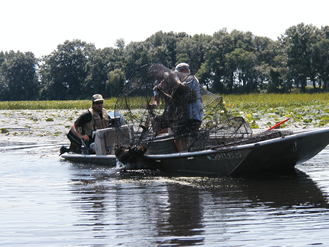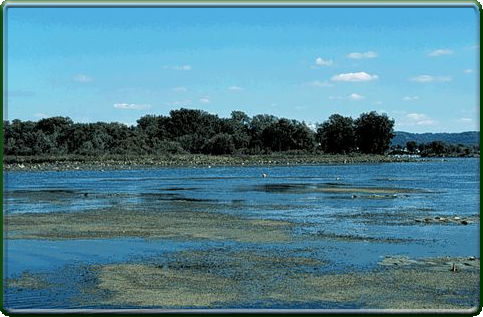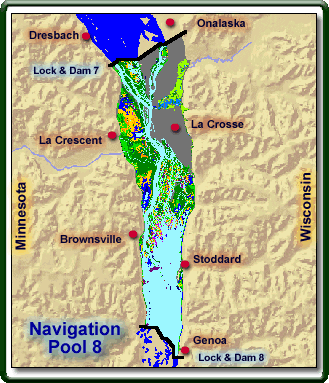- Home
- About S&T
- Taxa/Organisms
- Ecosystems
- Issues
- Methods & Tools
- Reports & Publications
- Location
- Search
Publisher: USGS | Science Center: Upper Midwest Environmental Sciences Center (UMESC, LaCrosse) | Format: URL
www.umesc.usgs.gov — This web resource provides decision makers with the information needed to maintain the Upper Mississippi River System as a viable multiple-use large river ecosystem. This resource also includes Data and sampling information, publication links, reports, other related documents and statistics, as well as links to field stations and other projects More...

Publisher: USGS | Science Center: Forest and Rangeland Ecosystem Science Center (FRESC, Corvallis) | Format: URL
fresc.usgs.gov — Biologists and managers on Washington's Olympic Peninsula, as throughout western Washington, are concerned about increased observations over the last several years of emaciated deer with symptoms of excessive hair-loss. This Web page describes a study to evaluate modern pellet-group survey methods, estimate abundance of deer and elk, identify More...

Publisher: USGS | Science Center: Fort Collins Science Center (FORT, Ft. Collins) | Format: URL
www.fort.usgs.gov — As one of one of the big three charismatic predators in North America, mountain lions top the list of national park management challenges that require balancing the preservation of species with protection of park visitors. In Rocky Mountain National Park and its environs, USGS Fort Collins Science Center (FORT) scientists are collaborating with More...

Publisher: USGS | Science Center: Western Ecological Research Center (WERC, Sacramento) | Format: URL
www.werc.usgs.gov — Invasion and subsequent restructuring of ecosystems by nonnative organisms is taking on increasingly urgent significance as an example of human-caused environmental change with potentially dramatic consequences. This web resource discusses the affects of vascular plants - particularly in Sequoia, Kings Canyon, and Yosemite National Parks - on the More...

Publisher: USGS | Science Center: Western Ecological Research Center (WERC, Sacramento) | Format: URL
www.werc.usgs.gov — Pinon-juniper woodlands have expanded beyond their historical range in the western United States, due partly to land management practices such as fire suppression that began with settlements of the region in the late 1880s. This woodland expansion has replaced sagebrush steppe vegetation, leading to decreased wildlife habitat, soil seedbanks, and More...

Publisher: USGS | Science Center: Western Ecological Research Center (WERC, Sacramento) | Format: URL
www.werc.usgs.gov — This issue overview focuses on nonnative grass invasions and fire in the Mojave Desert, which appear to have been infrequent historically. When fires occurred, gaps of plant-free space separating individual shrubs, bunchgrasses, cacti, and trees, stopped the spread of fires like networks of small firebreaks. The increasing dominance of nonnative More...

Publisher: USGS | Science Center: Western Ecological Research Center (WERC, Sacramento) | Format: URL
www.werc.usgs.gov — Radio transmitters, passively induce transponder (PIT) tags, visual surveys, and other methods and techniques are being evaluated to determine the habitat use and life history characteristics of the giant garter snake (Thamnophis gigas), a species endemic to Central Valley wetlands and federally listed as threatened.

Publisher: USGS | Science Center: Upper Midwest Environmental Sciences Center (UMESC, LaCrosse) | Format: URL
www.umesc.usgs.gov — After a series of navigation dams were constructed in the Upper Mississippi and Illinois Rivers in the 1930s, aquatic vegetation flourished. Its distribution, however, has fluctuated drastically in the 1980s and 1990s. As the navigation system ages, the fate of this important ecosystem component is a growing concern. This issue overview's More...

Publisher: USGS | Science Center: Western Ecological Research Center (WERC, Sacramento) | Format: URL
www.werc.usgs.gov — This web resource addresses the positive relationship between cheatgrass (Bromus tectorum) and fire frequency as a major concern for land managers in semi-arid shrublands throughout western North America, particularly in Great Basin sagebrush steppe. Management tools are needed to break this cycle, and in this project we will evaluate the use of More...

Publisher: USGS | Science Center: Upper Midwest Environmental Sciences Center (UMESC, LaCrosse) | Format: URL
www.umesc.usgs.gov — The diversity of habitat types, plants, and animals in the Upper Mississippi River has declined considerably over the last 50 years, creating loss of aquatic vegetation, loss of islands and side channels behind dams, and changes in river sediments, potentially caused by the method of managing water levels, which maintains artificially high water More...
